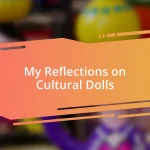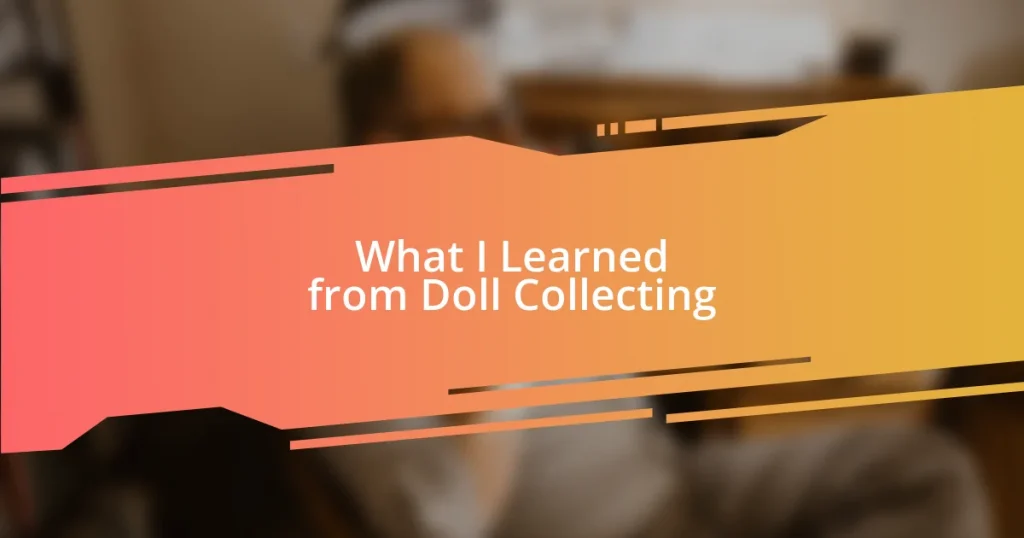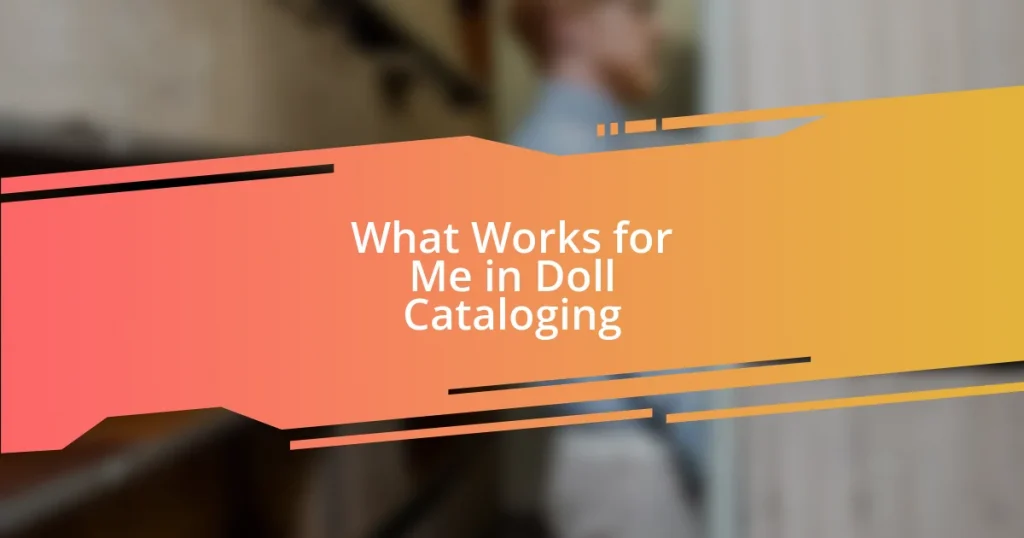Key takeaways:
- Understanding waste in crafting emphasizes both physical and emotional aspects, urging crafters to see potential in scraps instead of discarding them.
- Choosing sustainable materials, like recycled fabrics and eco-friendly adhesives, enhances the crafting experience while reducing environmental impact.
- Donating unused crafting items fosters community, promotes creativity in others, and reinforces the value of intentional resource sharing.
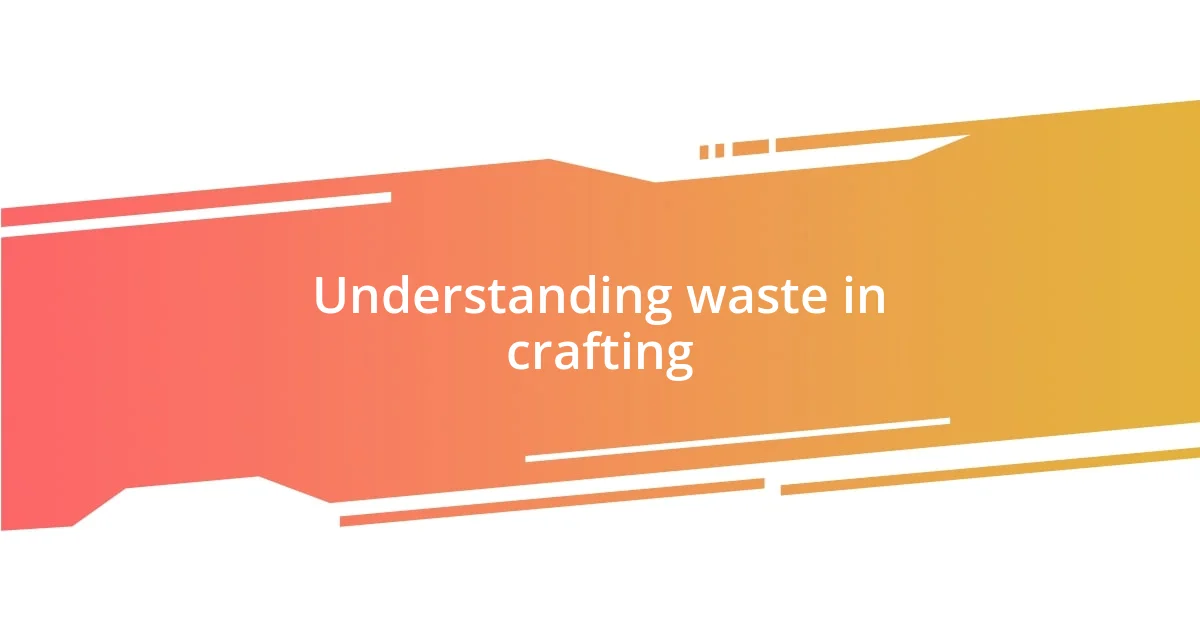
Understanding waste in crafting
Crafting, particularly doll crafting, is a joyous activity, but it often comes with its own set of waste challenges. I remember my early days filled with excitement as I created doll outfits, only to be left with a pile of fabric scraps. It was frustrating then, but it’s led me to think deeply about how much waste I was generating. How many of us have found ourselves discarding materials, thinking it’s just a small price to pay for creativity?
Understanding waste in crafting means recognizing that every little bit adds up. For instance, a simple project can yield more offcuts than you might expect. Once, while designing a tiny purse, I was shocked by the leftover leather. It made me question the sustainability of my craft. Are those scraps just remnants, or can they become new creations?
Waste in crafting isn’t just physical; it can also be emotional. There’s a sense of loss when you throw away something you once valued as part of your creative process. I’ve started keeping a box for all my leftover bits. It feels good to know that what once felt like waste can inspire the next project. Isn’t it rewarding to think that every piece has the potential to spark new ideas?
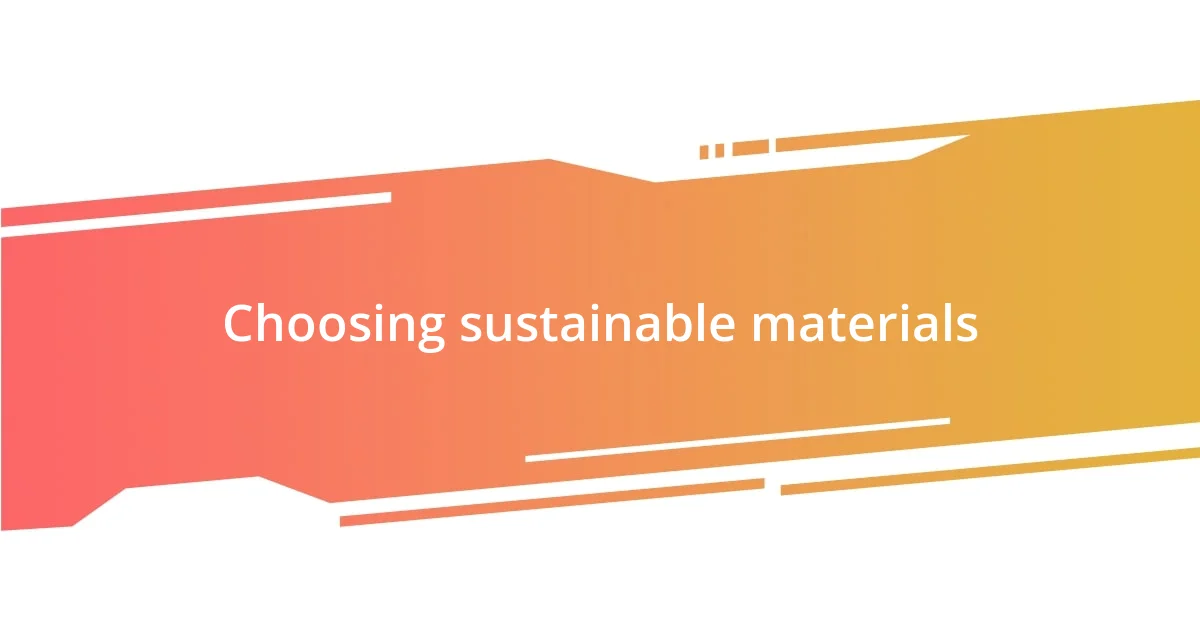
Choosing sustainable materials
When it comes to creating dolls, the choice of materials is crucial to minimizing waste. I’ve discovered that opting for sustainable materials not only reduces environmental impact but also enriches the crafting experience. For example, I began using organic cotton for doll clothing. The soft texture is delightful to work with, and I feel a sense of responsibility knowing it’s made without harmful chemicals.
Here are some sustainable materials to consider:
- Recycled fabrics: Great for reducing landfill waste and often come in unique patterns.
- Natural fibers: Like linen and hemp, these are biodegradable and produced without synthetic dyes.
- Upcycled materials: Using old clothing or scrap fabric can give new life to forgotten treasures.
- Eco-friendly glues and paints: Look for water-based, non-toxic options that are safer for both crafters and the planet.
Choosing the right materials can transform a simple crafting session into a mindful practice. I often find joy in the journey of finding these sustainable options. Recently, I salvaged some thread from an old project, which not only beautifully matched my doll’s outfit but also heightened my appreciation for reusing what I already had. That little extra effort made the end result feel more special, knowing I was contributing to a larger purpose.
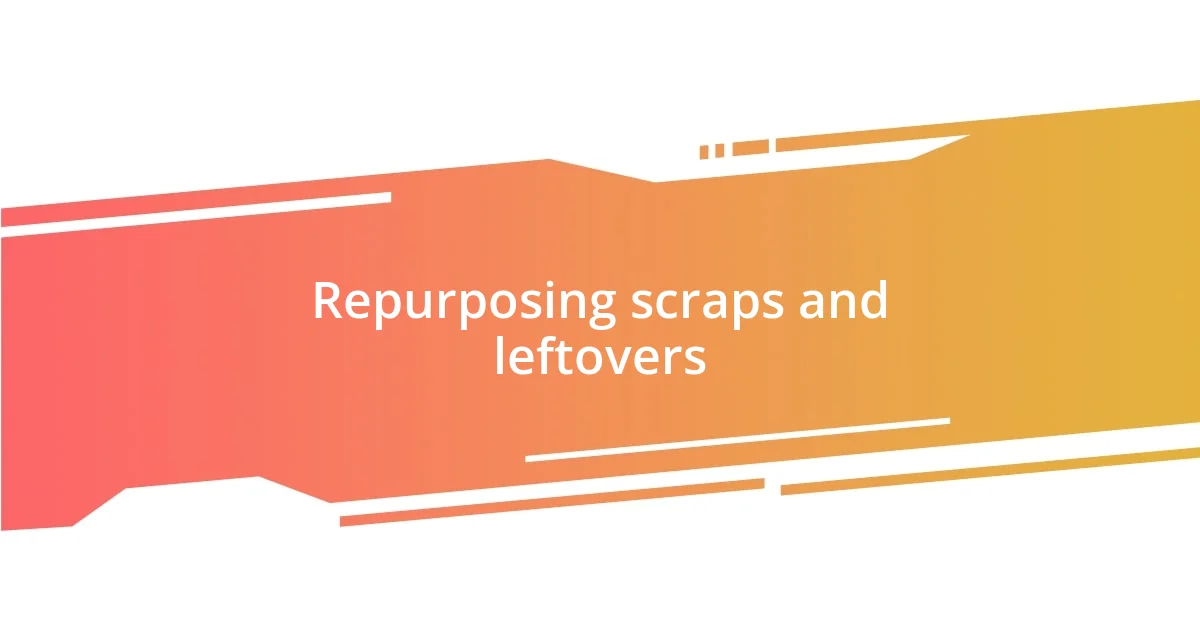
Repurposing scraps and leftovers
Repurposing scraps and leftovers is one of my favorite ways to breathe new life into materials that would otherwise go to waste. I’ve had a delightful experience turning fabric remnants into tiny accessories for my dolls. One day, I had a few colorful swatches left over from a dress I made, and I decided to stitch them together to create mini bags. It was both satisfying and creative, reminding me that even the smallest pieces can lead to something beautiful. Have you ever considered how leftovers can inspire ingenuity?
Another technique I’ve used is making patches out of my leftover scraps. Once, I crafted a patchwork quilt for my doll, fully utilizing various small pieces of fabric. Not only did it reduce waste, but it also added a unique character to the doll’s collection. The process was like a puzzle, and it felt amazing to see the final result. It’s like each piece tells its own story, creating a connection to past projects.
On a more practical note, I often use leftover yarn for doll hair. It’s a great way to achieve different textures and colors without additional purchases. The thrill of fishing through my yarn stash to find the perfect match adds an element of fun to the crafting process. Plus, it allows me to sit back and admire the diverse collection I’ve built over time. Each scrap holds potential; it just takes a bit of creativity to unlock it.
| Type of Scrap | Repurposing Ideas |
|---|---|
| Fabric | Mini accessories like bags, patches, or tiny quilts |
| Yarn | Doll hair or decorative trims |
| Buttons | Unique embellishments for clothing or accessories |

Efficient planning for projects
Efficient planning is essential to minimize waste in doll crafting. I find that mapping out my projects in advance helps avoid unnecessary material usage. For instance, I once got caught up in the excitement and started cutting fabric without a clear plan. It resulted in a heap of scraps that I later regretted. Now, I take the time to sketch out my designs and calculate the amount of material I need before diving in.
I often ask myself, “What materials do I really need for this project?” This simple question helps curb impulse buys and allows me to utilize what I already have. I remember a time when I was preparing for a new doll design, and rather than rushing to the store, I rummaged through my collection of fabrics. I ended up discovering some gorgeous remnants that not only fit my design but inspired a whole new concept. The thrill of unearthing hidden treasures can make planning feel rewarding rather than tedious.
Setting aside a little time for brainstorming also makes a world of difference. I’ve learned to think outside the box; sometimes, an idea springs forth during a quiet moment, igniting creative energy. During one of my planning sessions, I envisioned a doll with a vibrant patchwork dress made from various leftover fabrics. Instead of tossing out small remnants, I embraced them and turned the project into a celebration of creativity. It’s in those moments of planning that I find clarity and purpose, ensuring my waste is minimized while maximizing my enjoyment of crafting.

Utilizing eco-friendly adhesives
Utilizing eco-friendly adhesives is a game changer in doll crafting for both the environment and my creativity. I’ve made a conscious choice to swap out traditional glues for biodegradable options like natural rubber or plant-based adhesives. The first time I used an eco-friendly glue, I was surprised by its effectiveness – it held everything together firmly, yet I felt good knowing I wasn’t contributing to plastic waste.
There was this one project where I crafted a miniature dollhouse. I remember feeling a wave of satisfaction as I glued the pieces together with a water-based adhesive. I was completely absorbed in the moment, not just because of the joy of crafting, but also because I knew I was making a positive impact. After all, how often do we get to create something beautiful while taking care of our planet?
When considering adhesives, I also pay attention to the drying time and smell. I’ve had unpleasant experiences with off-gassing, where certain adhesives leave a lingering odor. This time, opting for a non-toxic glue not only made my work environment more pleasant but also felt safer for my kids to be around. Isn’t it wonderful how choosing the right materials can enhance both the crafting process and our health?
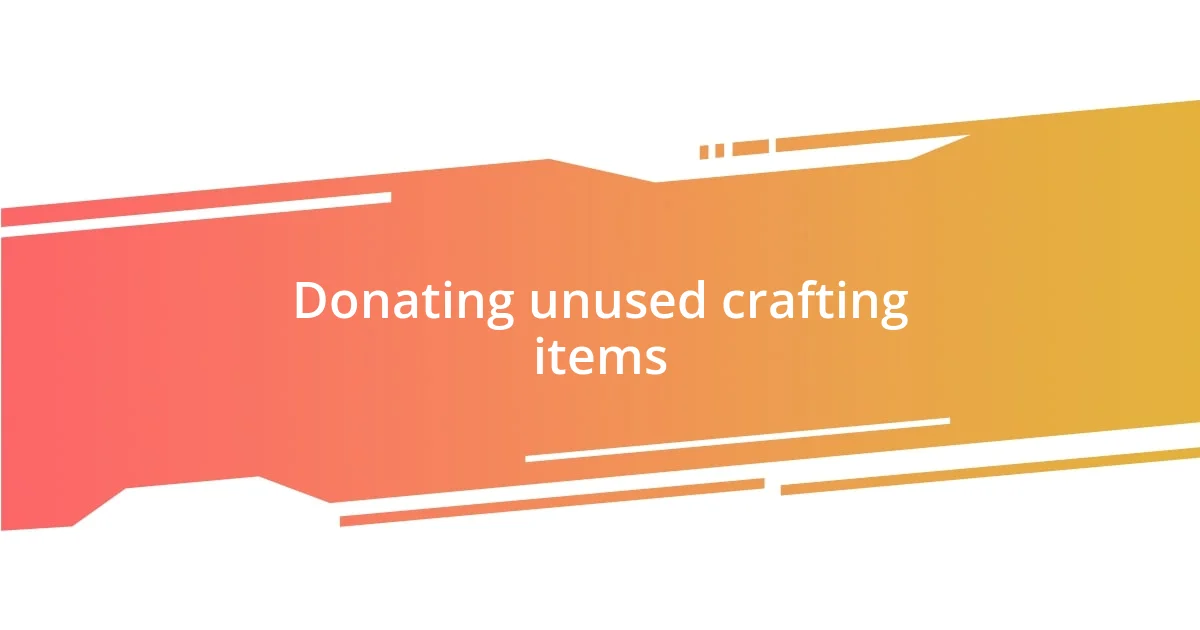
Donating unused crafting items
Donating unused crafting items is one of the most fulfilling ways to extend the life of materials I no longer need. Just recently, I came across an overflowing box of fabrics that I had once planned to use but had forgotten about. I decided to donate them to a local community center that runs art workshops for kids. Seeing those vibrant fabrics go to good use in the hands of budding creators was truly heartwarming.
I vividly remember the first time I donated some unused doll crafting items; it felt like a weight was lifted off my shoulders. What initially felt like clutter was transformed into potential for someone else’s project. It’s fascinating to consider how my cast-offs could spark imagination in others. Sharing resources like this not only helps those in need but also fosters a sense of community among crafters. Isn’t it rewarding to think that what I no longer value may become a cherished piece in someone else’s creative journey?
Moreover, I’ve learned to be intentional about what I choose to donate. Before letting go, I ask myself, “Will someone else truly find joy in this item?” If the answer is yes, I package it with care, sometimes even including a little note with crafting tips. This simple gesture adds a personal touch to my donations, reminding me that crafting is more than just a hobby; it’s a way to connect and uplift one another through creativity.

Sharing knowledge on minimalism
Minimizing waste in crafting aligns beautifully with the principles of minimalism, and I’ve found that sharing this knowledge can inspire others. Whenever I talk about how I simplify my crafting process, I can see the wheels turning in others’ minds, sparking their creativity. It’s fascinating to think that my insights on minimalism could motivate someone to make small, sustainable changes in their own crafting practices. Who knew that a simple conversation could lead to such impactful habits?
One day, I hosted a workshop on minimalist doll crafting, and I emphasized the idea of working with limited materials. It was remarkable to witness participants discovering the beauty in simplicity. I encouraged them to choose just a few colors and essential tools, and their creations were stunning! Isn’t it incredible how constraints can often fuel creativity? In fact, watching others realize that less can truly be more brought a sense of fulfillment that stayed with me long after the workshop ended.
I’ve also started a little book club with fellow crafters where we discuss books on minimalism and sustainable practices. Sharing our experiences has been eye-opening; many have shared how reducing excess has led to a clearer mind and a more joyful crafting experience. Don’t you think that crafting should be as much about the process and the journey as it is about the final product? This exchange of ideas reinforces my belief that minimalism isn’t just about using less; it’s about making space for what truly matters in our creative lives.






